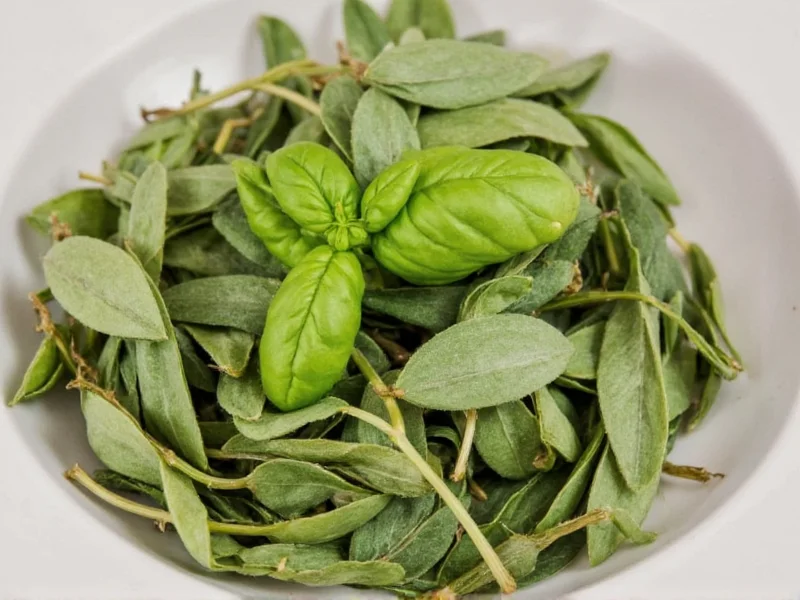If you're looking for a dried basil substitute, your best options are dried oregano (use 3/4 teaspoon oregano for every 1 teaspoon basil), Italian seasoning (use equal amounts), or a blend of thyme and marjoram. The ideal substitute depends on your specific recipe - oregano works well in tomato-based dishes like pizza sauce and pasta, while marjoram offers a milder alternative for delicate sauces. Always adjust quantities gradually as dried herbs are more concentrated than fresh.
Understanding Dried Basil's Unique Flavor Profile
Dried basil brings a sweet, slightly peppery flavor with hints of anise and clove to dishes. When dehydrated, its essential oils concentrate, making it more potent than fresh basil while losing some of the bright, grassy notes. This concentration means dried herb substitutions require careful measurement - typically using about 1/3 the amount of dried herb compared to fresh.
Top 5 Dried Basil Substitutes Ranked by Culinary Experts
Professional chefs and home cooks rely on these alternatives when dried basil isn't available. Each substitute brings its own flavor characteristics that work better in certain applications than others.
| Substitute | Best For | Substitution Ratio | Flavor Notes |
|---|---|---|---|
| Dried Oregano | Pizza sauce, tomato-based pasta sauces, meat dishes | 3/4 tsp oregano = 1 tsp basil | More pungent, earthier, slightly bitter |
| Italian Seasoning | General pasta dishes, soups, casseroles | 1:1 replacement | Complex blend with balanced herb notes |
| Dried Marjoram | Delicate sauces, fish dishes, vegetable preparations | 1:1 replacement | Sweeter, milder cousin of oregano |
| Dried Thyme | Heartier dishes, stews, roasted meats | 2/3 tsp thyme = 1 tsp basil | Earthy, lemony, more robust flavor |
| Dried Mint | Middle Eastern dishes, lamb recipes, some tomato sauces | 1/2 tsp mint = 1 tsp basil | Cooling effect, use sparingly |
When to Choose Each Dried Basil Alternative
Not all substitutes work equally well in every application. Understanding which alternative performs best in specific culinary contexts will save your dish from flavor imbalances.
For Italian Tomato-Based Dishes
When making pizza sauce or marinara, dried oregano serves as the most reliable dried basil replacement. Its earthy profile complements tomatoes beautifully, though it lacks basil's sweetness. For dried basil substitute for pasta sauce, use 3/4 teaspoon dried oregano for every teaspoon of dried basil called for. Add a pinch of sugar to compensate for the missing sweetness if needed.
For Delicate Sauces and Cream-Based Dishes
Marjoram's milder flavor makes it ideal when substituting in alfredo sauces or dishes where basil's presence should be subtle. Unlike oregano, marjoram won't overpower delicate flavors. Many professional chefs recommend this dried basil replacement in tomato sauce when you want a more nuanced herb profile without the sharpness of oregano.
For Mediterranean and Middle Eastern Cuisine
Dried mint works surprisingly well as a basil alternative in certain applications, particularly with lamb or in Greek-inspired dishes. Use half the amount you would basil, as mint's flavor is more assertive. This substitute shines when creating a dried basil substitute for pizza with Mediterranean toppings like olives and feta.
Creating Your Own Custom Basil Substitute Blend
For the most versatile dried basil alternative, create a custom blend that mimics basil's complex flavor profile:
- 2 parts dried oregano
- 1 part dried marjoram
- 1/2 part dried thyme
- Small pinch of dried mint (optional)
Mix these proportions thoroughly and store in an airtight container. Use this blend as a 1:1 replacement for dried basil in most recipes. This approach gives you the flexibility of what can I use instead of dried basil without compromising your dish's integrity.
Common Substitution Mistakes to Avoid
Many home cooks make critical errors when substituting dried herbs. Understanding these pitfalls will improve your results:
- Using equal amounts of fresh herbs - Remember that dried herbs are 2-3 times more potent than fresh. If substituting fresh for dried, triple the amount.
- Overcompensating with strong substitutes - Oregano and thyme can easily dominate a dish if used in equal amounts to basil.
- Ignoring dish acidity - In highly acidic tomato dishes, herb flavors diminish, so you may need slightly more substitute than the standard ratios suggest.
- Adding all at once - Always add dried herb substitutes gradually, tasting as you go, especially with potent alternatives like oregano.
Special Considerations for Specific Dishes
Certain recipes demand more thoughtful substitution strategies than others. Here's how to handle challenging applications:
Pizza Sauce Substitutions
For authentic-tasting pizza, combine 1/2 teaspoon dried oregano with 1/4 teaspoon dried marjoram per teaspoon of dried basil required. This blend provides the herbal complexity of basil without overwhelming the other ingredients. Many pizzerias actually prefer this combination over pure basil for a more robust flavor profile.
Pesto-Style Applications
When making a dried basil substitute for pesto, the challenge increases since basil is the star ingredient. In this case, reconstitute dried basil by steeping 1 teaspoon in 2 tablespoons of warm water for 10 minutes before using. If that's not possible, use a combination of dried parsley (1 tsp), dried mint (1/4 tsp), and a small pinch of dried tarragon to approximate basil's complex profile.
Cooking with Limited Herb Selection
If you only have basic dried herbs available, here's a practical approach: use 3/4 teaspoon dried oregano plus a tiny pinch of dried thyme for every teaspoon of dried basil needed. This works particularly well as a dried oregano instead of dried basil solution for most American-Italian dishes where perfect authenticity isn't critical.











 浙公网安备
33010002000092号
浙公网安备
33010002000092号 浙B2-20120091-4
浙B2-20120091-4